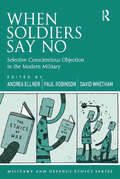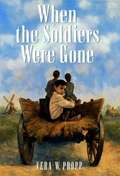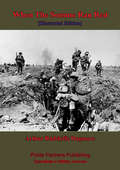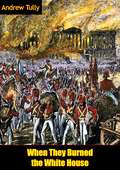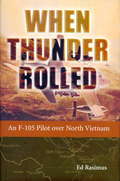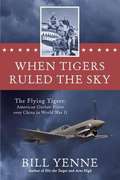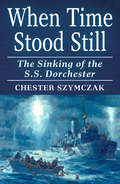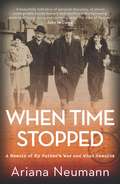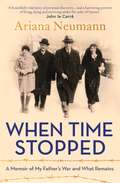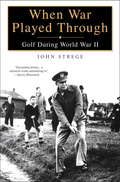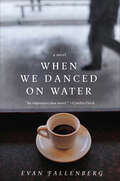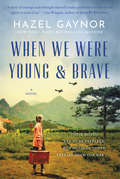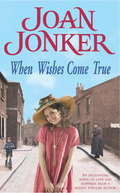- Table View
- List View
When Should A Commander Be Relieved?: A Study Of Combat Reliefs Of Commanders Of Battalions And Lower Units During The Vietnam Era
by Major Thomas V. DraudeThis study attempts to determine when commanders of battalions and lower units should be relieved during combat. The investigation analyzed actual reliefs during the Vietnam era to determine why the commanders were relieved, the availability of replacements, the role of counselling, and the effect on the unit.Investigation reveals that most reliefs were not caused by a single deficiency but rather by a combination of perceived shortcomings. Mission failure was not a significant reason for relief. Captains and lieutenants were more likely to be relieved than were lieutenant colonels. Replacements for the relieved commanders were usually available. Most reliefs were effected without prior counselling. The effect of the relief on the unit depended primarily on the unit's evaluation of the relieved commander's leadership and popularity.Further examination of the causes and effects of reliefs produced guidelines for commanders to consider before relieving a subordinate commander.
When Silence Falls
by Shirlee McCoyAn armed gunman tests a woman’s faith and her relationship with a handsome veteran in this inspirational romantic suspense novel.Life was busy and organized, just the way Lakeview music history professor Piper Sinclair liked it. Some recent family research even meant a new book to write. Until she witnessed an attempted kidnapping—and became a target herself. Someone wanted her out of the way permanently. Someone who seemed to know her all too well . . . His expertise as a former crime scene photographer left Cade Macalister with memories he couldn’t shake. Encountering Piper at the crime scene brought a different set to mind—his friend’s little sister had certainly grown up well, and she couldn’t take on this mysterious assailant alone. Of course, convincing Piper of that would be the only way to solve this dangerous riddle . . . and keep her alive.
When Sleeping Women Wake: A Novel
by Emma Pei YinIn this remarkable and harrowing debut novel, three extraordinary women—a mother, her daughter, and their maid—are each forced on a journey of survival during the Japanese occupation of Hong Kong in World War II.&“A lushly romantic and impassioned story of women&’s agency and resilience.&”—Juhea Kim, internationally bestselling author of Beasts of a Little Land and City of Night Birds1941. Following the Japanese invasion of Shanghai, the wealthy Tang family has settled in Hong Kong, believing it to be protected under British occupation. As the First Wife of the family, Mingzhu leads a glamorous, if at times lonely, existence—mothering the son of her husband&’s concubine, overseeing her daughter Qiang&’s education, and directing their household of servants, including her long-time confidante, Biyu.But when the Japanese invade Hong Kong, the paths of Mingzhu, Qiang, and Biyu wildly diverge. Although Mingzhu&’s affinity for languages spares her from physical labor, she finds herself coerced to either work for the enemy or face certain death. Qiang and Biyu scrape through days of factory work and meager food supplies, constantly on the run from newly unfolding dangers until an encounter with the East River Column resistance fighters separates them. The longer these women become embroiled in the brutal occupation that engulfs the region, the more determined they are to fight back—but can they support the resistance and still find their way back to one another?At once monumental and intimate, When Sleeping Women Wake powerfully explores how ordinary people are capable of extraordinary things, and the unwavering hope that love can carry us through even the darkest of times.
When Sleeping Women Wake: a sweeping historical WW2 novel with female resistance at its heart
by Emma Pei Yin'A heart-breaking, moving, and soaring novel. An important literary feat from an exciting new voice' NGUYỄN PHAN QUẾ MAI, global best-selling author of The Mountains Sing and Dust ChildHong Kong, 1941. Following the Japanese occupation of Shanghai, the wealthy Tang family flee to Hong Kong.As the First Wife of the family, Mingzhu leads a sheltered - if lonely - existence overseeing her daughter Qiang and managing the household alongside her devoted maid, Biyu.But when the Japanese army invade, the three women are scattered. Mingzhu is coerced into working for a Japanese captain. Qiang and Biyu escape the island, only to be forced into factory work then separated after an encounter with the East River Column Resistance fighters.The longer the brutal occupation lasts, the more determined the women are to resist. And as war rages around the world, each is holding onto the hope that the other is alive.Beautifully told and compulsively written, When Sleeping Women Wake is an utterly transporting story of female resistance and untold bravery, at once epic and intimate, heartbreaking and hopeful.Perfect for fans of Lisa See, Nguyễn Phan Quế Mai and Kristin Hannah.'A lushly romantic and impassioned story of women's agency and resilience' JUHEA KIM'Compelling, beautiful, and deeply moving . . . [a] stunning tale of love, loyalty and survival' WEINA DAI RANDEL'A breathtaking, important story of family, love and endurance . . . historical fiction at its finest' WIZ WHARTON
When Sleeping Women Wake: a sweeping historical WW2 novel with female resistance at its heart
by Emma Pei Yin'A heart-breaking, moving, and soaring novel. An important literary feat from an exciting new voice' NGUYỄN PHAN QUẾ MAI, global best-selling author of The Mountains Sing and Dust ChildHong Kong, 1941. Following the Japanese occupation of Shanghai, the wealthy Tang family flee to Hong Kong.As the First Wife of the family, Mingzhu leads a sheltered - if lonely - existence overseeing her daughter Qiang and managing the household alongside her devoted maid, Biyu.But when the Japanese army invade, the three women are scattered. Mingzhu is coerced into working for a Japanese captain. Qiang and Biyu escape the island, only to be forced into factory work then separated after an encounter with the East River Column Resistance fighters.The longer the brutal occupation lasts, the more determined the women are to resist. And as war rages around the world, each is holding onto the hope that the other is alive.Beautifully told and compulsively written, When Sleeping Women Wake is an utterly transporting story of female resistance and untold bravery, at once epic and intimate, heartbreaking and hopeful.Perfect for fans of Lisa See, Nguyễn Phan Quế Mai and Kristin Hannah.'A lushly romantic and impassioned story of women's agency and resilience' JUHEA KIM'Compelling, beautiful, and deeply moving . . . [a] stunning tale of love, loyalty and survival' WEINA DAI RANDEL'A breathtaking, important story of family, love and endurance . . . historical fiction at its finest' WIZ WHARTON
When Soldiers Say No: Selective Conscientious Objection in the Modern Military (Military and Defence Ethics)
by Paul Robinson David Whetham Andrea EllnerTraditionally few people challenged the distinction between absolute and selective conscientious objection by those being asked to carry out military duties. The former is an objection to fighting all wars - a position generally respected and accommodated by democratic states, while the latter is an objection to a specific war or conflict - theoretically and practically a much harder idea to accept and embrace for military institutions. However, a decade of conflict not clearly aligned to vital national interests combined with recent acts of selective conscientious objection by members of the military have led some to reappraise the situation and argue that selective conscientious objection ought to be legally recognised and permitted. Political, social and philosophical factors lie behind this new interest which together mean that the time is ripe for a fresh and thorough evaluation of the topic. This book brings together arguments for and against selective conscientious objection, as well as case studies examining how different countries deal with those who claim the status of selective conscientious objectors. As such, it sheds new light on a topic of increasing importance to those concerned with military ethics and public policy, within military institutions, government, and academia.
When Someone You Love Suffers from Posttraumatic Stress
by Claudia ZayfertFor trauma survivors struggling with intense memories and emotions, it often feels like life won't ever be "normal" again. Effective treatments are out there, but the needs of family members are often overlooked. Will the person you love ever get better? What can you do to promote healing? Where can you turn when you just can't cope? From experienced trauma specialists Drs. Claudia Zayfert and Jason C. DeViva, this compassionate guide is packed with information, support, vivid stories, and specific advice. Learn to navigate the rough spots day by day and help your loved one find a brighter tomorrow.
When The Soldiers Were Gone
by Vera W. ProppAt first Henk didn't believe what his Papa was saying. That the two strangers standing in the front room are his real parents, and now that the war is over they have come to take him back. He is told his name isn't even Henk, it's really Benjamin, and he's Jewish. But all Henk can remember is living on the farm with Papa, Mama, Miep, and Pieter. How can he possibly be expected to leave them? <P><P>Set in Holland just after the end of World War II, this is the moving story of a young boy adapting to life after the war with a family he doesn't remember.
When The Somme Ran Red [Illustrated Edition]
by Arthur Radclyffe DugmoreCaptain Dugmore stands as a rather strange figure even in the mass of personalities that fought in the Great War: an artist of some standing, a writer, and traveller. When the war broke out in 1914, he visited Belgium as a private citizen; appalled by the damage that the Germans, who were overrunning country in short order at the time, were wreaking he decided to join the British Army. There was only one small problem: at the time he was forty-four, too years too old to enter the army. But he strode into his local recruiting office and demanded admission to the army, and if met with refusal, he stated, he would return with a changed appearance and falsify his age!The army accepted Mr Dugmore as an officer and sent him off for immediate training. Despite having spent a large slice of his life in the outdoors in Africa painting and writing about wildlife, he must have found the trenches a shock. As he recounts in his book, he was strafed, shot at, barraged, and gassed during his time at the front, finally wounded and passed unfit for service in 1916 during the later phases of the battle of the Somme.The author's book is excellently written, filled with anecdote and detailed battle scenes. Author -- Captain Arthur Radclyffe Dugmore 1870 - 1955Text taken, whole and complete, from the edition published in New York, George H. Doran company 1918Original Page Count - 285 pagesIllustrations -- 20 maps and illustrations
When They Burned the White House [Illustrated Edition]
by Andrew TullyAt 9:45 p.m. on August 24, 1814, the British set fire to the White House and, within an hour, the Capitol had been gutted.How could this happen?The war was not widely supported and the defense of Washington had been placed in the hands of two inept and ill-appointed leaders-Secretary of War Armstrong and Brigadier General Winder-whose "thimble headed stupidity" meant that the arriving British troops met little resistance. There were heroes in the mix: the U.S. First Lady, Dolley Madison, stayed until the last moment and, with the help of her servants, managed to save important books, a portrait of George Washington, and a copy of the Declaration of Independence.Ironically, the burning of the White House had a galvanizing effect on the divided views of the young country. "Overnight, the nation united in its determination to pursue this unpopular war with new vigor, to take its revenge on a power which had shamed an independent people by burning its capital."President Madison had, at last, the support he needed.Award winning author and newspaperman, Andrew Tully, has added flesh to the bones of this true story of an often over-looked and confusing period of U.S. history.Well-researched and historically accurate, When They Burned the White House is a fascinating read for U.S. history buffs eager for more information about the War of 1812 and all readers interested in historical drama.Illustrated throughout by celebrated graphic designer Milton Glaser."Well told...attractive...lively"--Allen Drury, author of Advise and Content and A Shade of Difference
When Thunder Rolled
by Ed RasimusEd Rasimus straps the reader into the cockpit of an F-105 Thunderchief fighter-bomber in his engaging account of the Rolling Thunder campaign in the skies over North Vietnam. Between 1965 and 1968, more than 330 F-105s were lost--the highest loss rate in Southeast Asia--and many pilots were killed, captured, and wounded because of the Air Force's disastrous tactics. The descriptions of Rasimus's one hundred missions, some of the most dangerous of the conflict, will satisfy anyone addicted to vivid, heart-stopping aerial combat, as will the details of his transformation from a young man paralyzed with self-doubt into a battle-hardened veteran. His unique perspective, candid analysis, and the sheer power of his narrative rank his memoir with the finest, most entertaining of the war.From the Hardcover edition.
When Tigers Ruled the Sky: American Outlaw Pilots over China in World War II
by Bill YenneFrom the acclaimed author of Hit the Target and Big Week, an in-depth account of the legendary World War II combat group, the Flying Tigers.In 1940, Pearl Harbor had not yet happened, and America was not yet at war with Japan. But China had been trying to stave off Japanese aggression for three years--and was desperate for aircraft and trained combat pilots.General Chiang Kai-shek sent military aviation advisor Claire Chennault to Washington, where President Roosevelt was sympathetic, but knew he could not intervene overtly. Instead, he quietly helped Chennault put together a group of American volunteer pilots.This was how the 1st American Volunteer Group--more commonly known as the Flying Tigers--was born.With the trademark smiling shark jaws on their P-40 fighters, these Army, Navy and Marine pilots became a sensation as they fought for the Chinese. Those who initially doubted them were eventually in awe as they persevered over Rangoon despite being outnumbered 14-1 by Japanese aircraft; as they were described by Madame Chiang Kai-shek as her "little angels" and by a Chinese foreign minister as "the soundest investment China ever made"; and as they ultimately destroyed hundreds of Japanese planes while losing only a dozen of their own in combat. Two of their veterans would later earn the Medal of Honor--and as a group, the Flying Tigers managed to rack up a better record than any other air wing in the Pacific theater. When Tigers Ruled the Sky is a thrilling and triumphant account of their courage and their legacy.
When Time Stood Still: The Sinking of the S.S. Dorchester
by Chester J. SzymczakWhen Time Stood Still, first published in 1956, is the account of the sinking of the S.S. Dorchester, an army transport ship, by a German submarine in the North Atlantic in February 1943. Author and crewman Chester Szymczak was working aboard the Dorchester, and was one of nine survivors of the crew of 23. Tragically, of the 900 military servicemen traveling aboard as passengers, 678 were lost in the frigid waters. Also of note was the presence of four chaplains, each representing a different faith, who went down with the ship as they worked together in assisting passengers with lifejackets and in helping them get off the rapidly sinking ship. Fortunately, three U.S. Coast Guard Cutters were part of the transport convoy, and were able to pull a number passengers from the sea.
When Time Stopped: A Memoir of My Father's War and What Remains
by Ariana NeumannA Simon & Schuster eBook. Simon & Schuster has a great book for every reader.
When Time Stopped: A Memoir of My Father's War and What Remains
by Ariana Neumann&‘Beautifully told' John Le Carre &‘More than just history&’ Michael Palin &‘Truly exceptional&’ Jon Snow &‘Absolutely remarkable&’ Edmund de Waal &‘Beautifully written&’ Stephen D. Smith In this remarkably moving memoir, Ariana Neumann dives into the secrets of her father&’s past: years spent hiding in plain sight in wartorn Berlin, the annihilation of dozens of family members in the Holocaust, and the courageous choice to build anew. &‘The darkest shadow is beneath the candle.&’ As a child in Venezuela, Ariana Neumann is fascinated by the enigma of her father, who appears to be the epitome of success and strength, but who wakes at night screaming in a language she doesn&’t recognise. Then, one day, she finds an old identity document bearing his picture – but someone else&’s name. From a box of papers her father leaves for her when he dies, Ariana meticulously uncovers the extraordinary truth of his escape from Nazi-occupied Prague. She follows him across Europe and reveals his astonishing choice to assume a fake identity and live out the war undercover, spying for the Allies in Berlin – deep in the &‘darkest shadow&’. Having known nothing of her father&’s past, not even that he was Jewish, Ariana&’s detective work also leads to the shocking discovery that a total of twenty-five members of the Neumann family were murdered by the Nazis.Spanning nearly ninety years and crossing oceans, When Time Stopped is a powerful and beautifully wrought memoir in which Ariana comes to know the family that has been lost – and, ultimately, her own beloved father.
When War Played Through
by John StregeThe New York Timesbestselling author pays tribute to the golfers who rallied for an Allied victory during World War II-and shows how the Greatest Generation kept golf alive, despite equipment shortages, bombings, and even captivity. World War II transformed the American home front, and golf was no exception. The world-famous Masters course at Augusta National became a farm to ease food shortages. Ben Hogan and Sam Snead were drafted, and Bobby Jones enlisted. Rubber rationing forced pros and amateurs alike to play with well-worn golf balls-and created a black market for new ones. The 1942 U. S. Open was canceled, replaced by the Hale American Open-whose winner, Ben Hogan, was awarded $1,000 in war bonds-while golfers across the country raised millions of dollars for the war effort. When War Played Throughbrings to life these little-known aspects of an endlessly fascinating period in golf's history. Bestselling golf author John Strege's narrative extends overseas to captured soldiers in Germany who constructed golf courses in a POW camp and English golfers who devised rules for playing around bomb craters and shrapnel during the Blitz (from the Richmond Gold Club in London: "A player whose stroke is affected by the simultaneous explosion of a bomb may play another ball. Penalty one stroke. "). Many golfers returned home from battle with commendations for valor, finding unmatched solace on the links after a dark time. When War Played Throughis the compelling story how an elite sport became a selfless one-and how golf became, for a nation at war, much more than a game.
When War Played Through
by John StregeWorld War II transformed the American home front, and golf was no exception. The world-famous Masters course at Augusta National became a farm to ease food shortages. Ben Hogan and Sam Snead were drafted, and Bobby Jones enlisted. Rubber rationing forced pros and amateurs alike to play with well-worn golf balls--and created a black market for new ones. The 1942 U.S. Open was canceled, replaced by the Hale American Open--whose winner Ben Hogan was awarded $1000 in war bonds--while golfers across the country raised millions of dollars for the war effort. When War Played Through brings to life these little-known aspects of an endlessly fascinating period in golf's history. Bestselling golf author John Strege's narrative extends overseas, to captured soldiers in Germany who constructed golf courses in a POW camp and English golfers who devised rules for playing around bomb craters and shrapnel during the Blitz. Many golfers returned home from battle with commendations for valor, finding unmatched solace on the links after a dark time. When War Played Through is the compelling story of how an elite sport became a selfless one--and how golf became, for a nation at war, much more than a game.
When We Danced on Water: A Novel
by Evan FallenbergFromacclaimed author Evan Fallenberg, an exquisitelycrafted debut novel tells the story of a preeminent male ballet dancer in theautumn of his career—a Jew whose talent once saved him from the Nazis—whosefading passion for life will flare back to life after a new romance links himto a younger woman fleeing the ghosts of her past as an Israeli Soldier. Fallenberg’s Tel Aviv-set tale that will resonate withreaders of Wladyslaw Szpilman’sThe Pianist, Dalia Sofer’sThe Septembers of Shiraz, and Thrity Umrigar’s The Space Between Us, as well as any whohave been touched by war or diaspora, as two characters’ intimate journeypoignantly explores the pain of fractured pasts, the hope for second chances, thepotency of artistic catharsis, and the certainty that love can conquer all.
When We Had Wings
by Susan Meissner Ariel Lawhon Kristina McMorrisFrom three bestselling authors comes an interwoven tale about a trio of World War II nurses stationed in the South Pacific who wage their own battle for freedom and survival.The Philippines, 1941. When U.S. Navy nurse Eleanor Lindstrom, U.S. Army nurse Penny Franklin, and Filipina nurse Lita Capel forge a friendship at the Army Navy Club in Manila, they believe they&’re living a paradise assignment. All three are seeking a way to escape their pasts, but soon the beauty and promise of their surroundings give way to the heavy mantle of war.Caught in the crosshairs of a fight between the U.S. military and the Imperial Japanese Army for control of the Philippine Islands, the nurses are forced to serve under combat conditions and, ultimately, endure captivity as the first female prisoners of the Second World War. As their resiliency is tested in the face of squalid living arrangements, food shortages, and the enemy&’s blatant disregard for the articles of the Geneva Convention, the women strive to keep their hope— and their fellow inmates—alive, though not without great cost.In this sweeping story based on the true experiences of nurses dubbed &“the Angels of Bataan,&” three women shift in and out of each other&’s lives through the darkest days of the war, buoyed by their unwavering friendship and distant dreams of liberation.&“Three of the biggest powerhouses in historical fiction come together to pen this breathtaking story of three nurses serving in the Philippines during the Second World War.&” —PAM JENOFF, New York Times bestselling author of The Woman with the Blue Star World War II historical fictionStand-alone novelBook length: approximately 128,000 wordsIncludes discussion questions for book clubs
When We Meet Again: A sweeping and heart-breaking WW2 novel from a New York Times bestselling author
by Kristin Harmel'Kristin Harmel is firmly in the top echelon of WW2 storytellers' HEATHER MORRIS'A master storyteller' SANTA MONTEFIORESome secrets echo through timeEmily Emerson has recently lost her job and is looking for a new purpose in life. When a mysterious parcel comes her way, she's intrigued. Inside is a painting of a beautiful woman standing at the edge of a sugarcane field, and attached is a note: 'He never stopped loving her ...'Emily recognises the young woman as her much-missed and beloved grandmother, but where was she, and who sent the painting? As Emily delves further, she uncovers a trail leading to a pivotal moment in twentieth-century American history, and a link with the portrait that reveals long-buried family secrets that ripple through the ages.An unforgettable and sweeping story of love and survival against the odds.From New York Times bestselling author Kristin Harmel, a beautifully repackaged and updated edition of WHEN WE MEET AGAIN which has been refreshed by the author including a new author's note.
When We Meet Again: A sweeping and heart-breaking WW2 novel from a New York Times bestselling author
by Kristin Harmel'Kristin Harmel is firmly in the top echelon of WW2 storytellers' HEATHER MORRIS'A master storyteller' SANTA MONTEFIORESome secrets echo through timeEmily Emerson has recently lost her job and is looking for a new purpose in life. When a mysterious parcel comes her way, she's intrigued. Inside is a painting of a beautiful woman standing at the edge of a sugarcane field, and attached is a note: 'He never stopped loving her ...'Emily recognises the young woman as her much-missed and beloved grandmother, but where was she, and who sent the painting? As Emily delves further, she uncovers a trail leading to a pivotal moment in twentieth-century American history, and a link with the portrait that reveals long-buried family secrets that ripple through the ages.An unforgettable and sweeping story of love and survival against the odds.From New York Times bestselling author Kristin Harmel, a beautifully repackaged and updated edition of WHEN WE MEET AGAIN which has been refreshed by the author including a new author's note.
When We Were Young
by Jaclyn GoldisThree generations of women come together in this page-turning debut full of family secrets, heart-wrenching drama, and the promise of second chances.Corfu, 1942: To sixteen-year-old Sarah Batis, the Nazis are a distant danger—of far greater threat is the opposing needs of her heart and her people. Tradition demands that Sarah marry a Jewish man. Only Sarah has fallen in love with a fisherman outside their community. And when the Nazis invade, Sarah must watch from afar as her family is taken away. . .Corfu, 2004: Sarah's daughter, Bea, has built a happy life with a steadfast husband and two independent daughters. Their summers on the Greek island with the Winn family appear idyllic, especially the love that blossoms between Bea's daughter Joey and Leo Winn. But there is a secret threatening their beach paradise.Florida, 2019:Joey is only days away from marrying the nice Jewish man her family adores. The arrival of Leo, Joey's first love, sends her reeling. Even after fifteen years, the attraction between them burns bright—but Leo isn't looking for a happy reunion. He's there to reveal why he really broke up with her during their last summer together. Weddings have a way of bringing out the best—and worst—in those you love the most. And as the revelations of her family flood to the surface, what Joey learns will either bring them closer together . . . or tear them apart forever.
When We Were Young & Brave: A Novel
by Hazel Gaynor"Gaynor's story of courage and strength will make you believe in the heroic spirit in each of us." —Lisa Wingate, #1 New York Times bestselling author of Before We Were YoursThe New York Times bestselling author of The Girl Who Came Home sets her unforgettable new novel in China during WWII, inspired by true events surrounding the Japanese Army’s internment of teachers and children from a British-run missionary school.Their motto was to be prepared, but nothing could prepare them them for war. China, December 1941. Having left an unhappy life in England for a teaching post at a missionary school in northern China, Elspeth Kent is now anxious to return home to help the war effort. But as she prepares to leave China, a terrible twist of fate determines a different path for Elspeth, and those in her charge. Ten-year-old Nancy Plummer has always felt safe at Chefoo School, protected by her British status. But when Japan declares war on Britain and America, Japanese forces take control of the school and the security and comforts Nancy and her friends are used to are replaced by privation, uncertainty and fear. Now the enemy, and separated from their parents, the children look to their teachers – to Miss Kent and her new Girl Guide patrol especially – to provide a sense of unity and safety. Faced with the relentless challenges of oppression, the school community must rely on their courage, faith and friendships as they pray for liberation – but worse is to come when they are sent to a distant internment camp where even greater uncertainty and danger await . . . Inspired by true events, When We Were Young and Brave is an unforgettable novel about impossible choices and unimaginable hardship, and the life-changing bonds formed between a young girl and her teacher in a remote corner of a terrible war.
When Wishes Come True: A moving wartime saga of love, motherhood and freedom
by Joan JonkerA young mother is left abandoned, yet finds strength in the busy streets and communities of Liverpool. Joan Jonker's heart-warming saga, When Wishes Come True, is guaranteed to bring tears of sadness and joy to readers everywhere. Perfect for fans of Katie Flynn and Cathy Sharp.Evelyn Wilkinson married Charles Lister-Sinclair just hours before he left for war, unaware that she would never see him again and that she was already carrying his child. When Amelia is born, Charles's parents refuse to accept that she is their grandchild, so, penniless and afraid, Evelyn moves to the backstreets of Liverpool where she dreams of escaping. Meanwhile, as little Milly grows up she discovers that a world of happiness lies on her doorstep. What readers are saying about When Wishes Come True: 'What a great book to read, couldn't read it fast enough as I was gripped from the very first page' 'I've read lots of Joan Jonker's books. This is one that surpasses all others. Full of love, sorrow, comedy and emotions'
When You and I Collide
by Kate NorrisA race against time, war, and the very fabric of the universe itself, perfect for fans of Sliding Doors and 11/22/63.Sixteen-year-old Winnie Schulde has always seen splits--the moment when two possible outcomes diverge, one in her universe and one in another. Multiverse theory, Winnie knows, is all too real, though she has never been anything but an observer of its implications--a secret she keeps hidden from just about everyone, as she knows the uses to which it might be put in the midst of a raging WWII. But her physicist father, wrapped up in his research and made cruel by his grief after the loss of Winnie's mother, believes that if he pushes her hard enough, she can choose one split over another and maybe, just maybe, change their future and their past. Winnie is certain that her father's theories are just that, so she plays along in an effort to placate him. Until one day, when her father's experiment goes wrong and Scott, the kind and handsome lab assistant Winnie loves from afar, is seriously injured. Without meaning to, Winnie chooses the split where Scott is unharmed. And in doing so, finds herself pulled into another universe, an alternate reality. One that already has a Winnie. In this darkly thrilling novel that blends science and war with love and loss, some actions just can't be undone.Praise for When You and I Collide: "A serious tale of attempting reinvention at the cost of rending reality." --Kirkus Reviews





